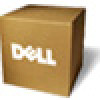Dell S1709WFP User's Guide - Page 27
Product Specific Problems, Troubleshooting Your Soundbar
 |
View all Dell S1709WFP manuals
Add to My Manuals
Save this manual to your list of manuals |
Page 27 highlights
Image Retention (from a static image) Faint Shadow from the static image displayed appears on the screen l Perform monitor reset. l Perform monitor self-test feature check to determine if the intermittent problem occurs in self-test mode. l Use the Power Management feature to turn off the monitor at all times when not in use. Alternatively, use a dynamically changing screen saver left on the monitor for a long period of time. Product Specific Problems SPECIFIC SYMPTOMS Screen image is too small Cannot adjust the monitor with the buttons on the front panel WHAT YOU EXPERIENCE POSSIBLE SOLUTIONS Image is centered on screen, but does not fill entire viewing area. l Perform monitor reset on "All Settings." OSD does not appear on the screen. l Turn off the monitor, unplug the power cord and then plug back and turn on the monitor. Troubleshooting Your Soundbar COMMON SYMPTOMS No Sound WHAT YOU EXPERIENCE No power to Soundbar, the power indicator is off. (built-in DC power supply.) POSSIBLE SOLUTIONS l Turn the Power/Volume knob on the Soundbar clockwise to the middle position; check if the power indicator (green LED) on the front of the Soundbar is illuminated. l Confirm that the power cable from the Soundbar is plugged into the adapter. No Sound Soundbar has power - power indicator is on. l Plug the audio line-in cable into the computer's audio out jack. l Set all Microsoft® Windows® volume controls to their maximum. l Play some audio content on the computer (i.e. audio CD, or MP3). l Turn the Power/Volume knob on the Soundbar clockwise to a higher volume setting. l Clean and reseat the audio line-in plug. l Test the Soundbar using another audio source (i.e. portable CD player). Distorted Sound Computer's sound card is used as the audio source. l Clear any obstructions between the Soundbar and the user. l Confirm that the audio line-in plug is completely inserted into the jack of the sound card. l Set all Windows volume controls to their midpoints. l Decrease the volume of the audio application. l Turn the Power/Volume knob on the Soundbar counter-clockwise to a lower volume setting. l Clean and reseat the audio line-in plug. l Troubleshoot the computer's sound card. l Test the Soundbar using another audio source (i.e. portable CD player). Distorted Sound Other audio source is used. l Clear any obstructions between the Soundbar and the user. l Confirm that the audio line-in plug is completely inserted into the jack of the audio source. l Decrease the volume of the audio source. l Turn the Power/Volume knob on the Soundbar counter-clockwise to a lower volume setting. l Clean and reseat the audio line-in plug. Unbalanced Sound Sound from only one side of Output Soundbar. l Clear any obstructions between the Soundbar and the user. l Confirm that the audio line-in plug is completely inserted into the jack of the sound card or audio source. l Set all Windows audio balance controls (L-R) to their midpoints. l Clean and reseat the audio line-in plug. l Troubleshoot the computer's sound card. l Test the Soundbar using another audio source (i.e. portable CD player). Low Volume Volume is too low. l Clear any obstructions between the Soundbar and the user. l Turn the Power/Volume knob on the Soundbar clockwise to the maximum volume setting. l Set all Windows volume controls to their maximum. l Increase the volume of the audio application. l Test the Soundbar using another audio source (i.e. portable CD player). Back to Contents Page










